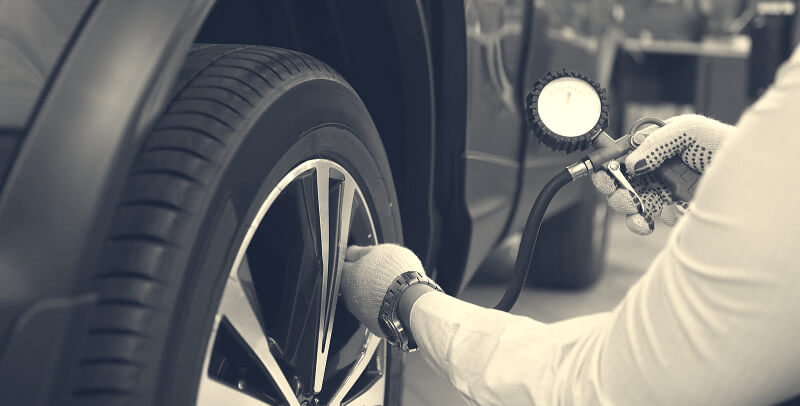The Importance Of Proper Tire Inflation

Proper tire inflation is crucial for ensuring optimal vehicle performance and safety on the road. Inadequate tire pressure can lead to a host of problems, including reduced fuel efficiency, impaired handling, and increased risk of tire damage.
This article will discuss what proper tire inflation entails, its importance, and the consequences of both underinflation and over inflation. We will also offer tips for maintaining proper tire pressure and using tire pressure monitoring systems.
What Proper Tire Inflation Means?
Proper tire inflation inflates a tire to its recommended pressure, typically specified by the vehicle manufacturer. This recommended pressure, measured in pounds per square inch (PSI), ensures that the tire can support the vehicle’s weight and maintain optimal contact with the road surface, resulting in improved handling, fuel efficiency, and tire longevity.
The importance of maintaining proper tire inflation is essential for several reasons. It helps:
- Extend tire lifespan by reducing wear and tear
- Improve fuel efficiency by reducing rolling resistance
- Enhance vehicle handling and stability, particularly in emergencies
- Minimize the risk of tire blowouts and other types of tire damage
- Decrease greenhouse gas emissions by improving fuel economy
The Consequences of Underinflation
Underinflated tires pose several risks, including:
- Increased tire wear and potential for blowouts: Underinflated tires cause uneven wear, particularly on the outer edges, and can lead to premature tire failure or blowouts.
- Reduced fuel efficiency and increased emissions: Underinflated tires have increased rolling resistance, which requires more energy to move the vehicle and results in higher fuel consumption and emissions.
- Impaired handling and decreased safety: Underinflated tires can compromise vehicle handling and stability, making it difficult to control the vehicle in turns or emergency situations.
The Consequences of Over inflation
Overinflated tires also come with their own set of risks:
- Uneven tire wear and decreased lifespan: Overinflated tires tend to wear unevenly in the center, reducing their overall lifespan.
- Reduced traction and handling: Overinflated tires have a smaller contact patch with the road surface, resulting in reduced traction and compromised handling.
- Potential for tire damage or failure: Overinflated tires are more susceptible to damage from road debris, potholes, or other impacts, increasing the risk of tire failure.
Tips for Maintaining Proper Tire Inflation
To ensure proper tire inflation, follow these guidelines:
- Consult your vehicle’s owner’s manual or the information placard on the driver’s side door jamb for the recommended tire pressure.
- Check tire pressure regularly, at least once a month and before long trips, when the tires are cold (i.e., the vehicle has been stationary for at least three hours).
- Be aware of temperature changes, as tire pressure can fluctuate with temperature; typically, tire pressure decreases by 1 PSI for every 10-degree Fahrenheit drop in temperature.
- Consider using a tire pressure monitoring system (TPMS) to receive real-time information on tire pressure and alerts when pressure falls below the recommended levels.
Can Over Inflation Damage Tires?
Yes, over inflation can damage tires. When tires are overinflated, they become more rigid, and the tread’s center bears most of the vehicle’s weight, which can cause the tire to wear more quickly in the center. Over-inflation can also lead to a harsher ride, reduced traction, and increased blowout risk.
Additionally, over inflated tires may have a smaller contact patch with the road, negatively impacting braking distance and handling. It’s important to keep your tires properly inflated to ensure their longevity and your safety on the road.
How Much Should I Inflate My Tires?
The appropriate tire pressure for your vehicle can usually be found in the owner’s manual or on a sticker inside the driver’s side door jamb, fuel door, or glove compartment. Tire pressure is measured in pounds per square inch (psi) or kilopascals (kPa).
It’s important to note that the recommended tire pressure may differ for the front and rear tires, so be sure to check both values. Also, remember that the recommended pressure is for cold tires, as tire pressure can increase as the tires heat up during driving.
To maintain the correct tire pressure:
- Use a reliable tire pressure gauge to check your tire pressure at least once a month and before long trips. Do this when the tires are cold, preferably in the morning or after the car has been parked for a few hours.
- Compare the measured tire pressure with the recommended values in your owner’s manual or the tire information placard.
- If the pressure is too low, inflate the tires to the recommended level. If the pressure is too high, release some air until the correct pressure is reached.
- Don’t forget to check and maintain the pressure of your spare tire as well.
Maintaining the proper tire pressure will help ensure optimal vehicle performance, improve fuel efficiency, and reduce tire wear, leading to a safer and more enjoyable driving experience.
Conclusion
Proper tire inflation is essential for maintaining vehicle performance, safety, and fuel efficiency. Regularly monitoring tire pressure and adhering to the recommended inflation guidelines can help prevent the risks associated with underinflation and over inflation. Following the tips outlined in this article, drivers can enjoy a safer, more efficient, and environmentally responsible driving experience.

